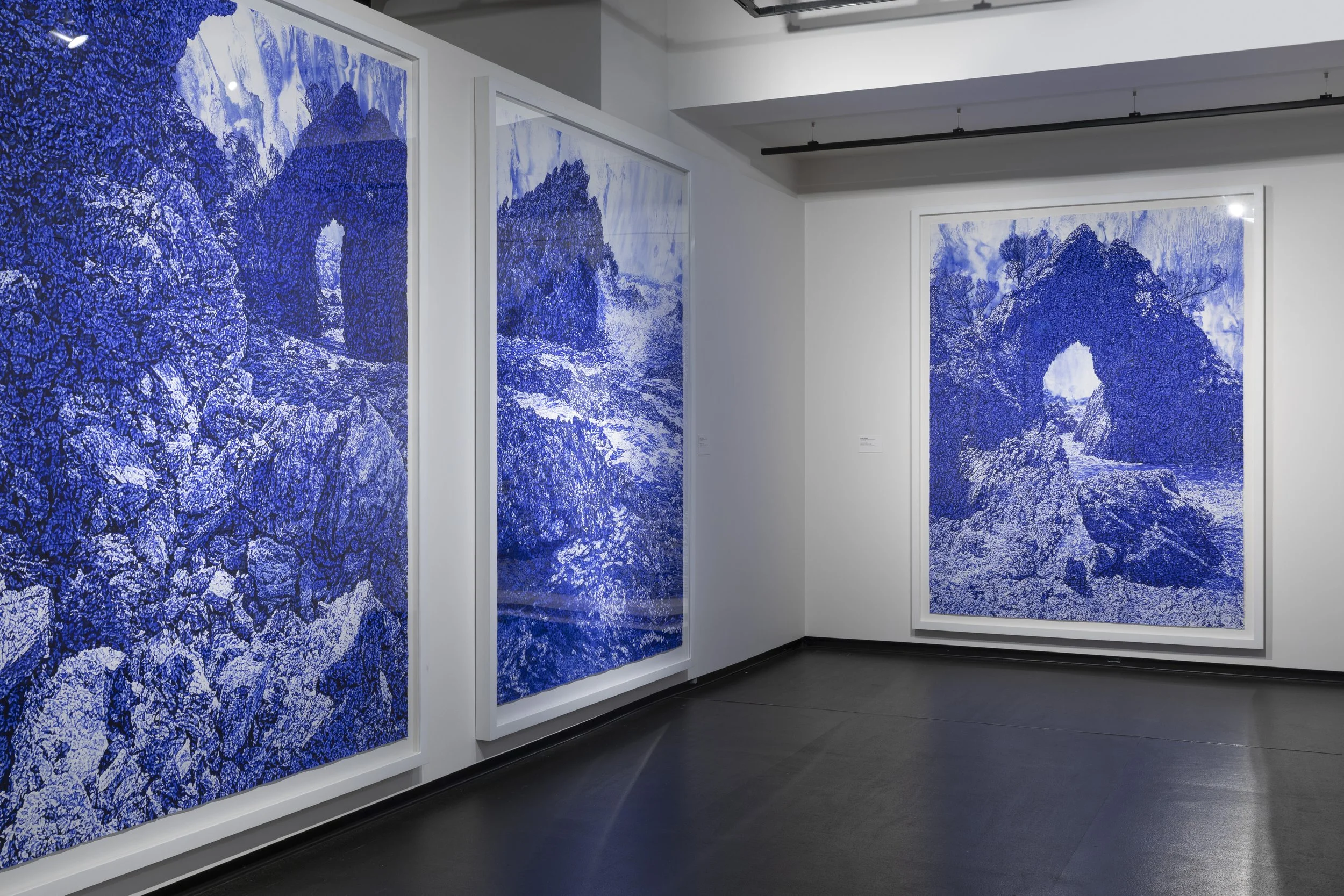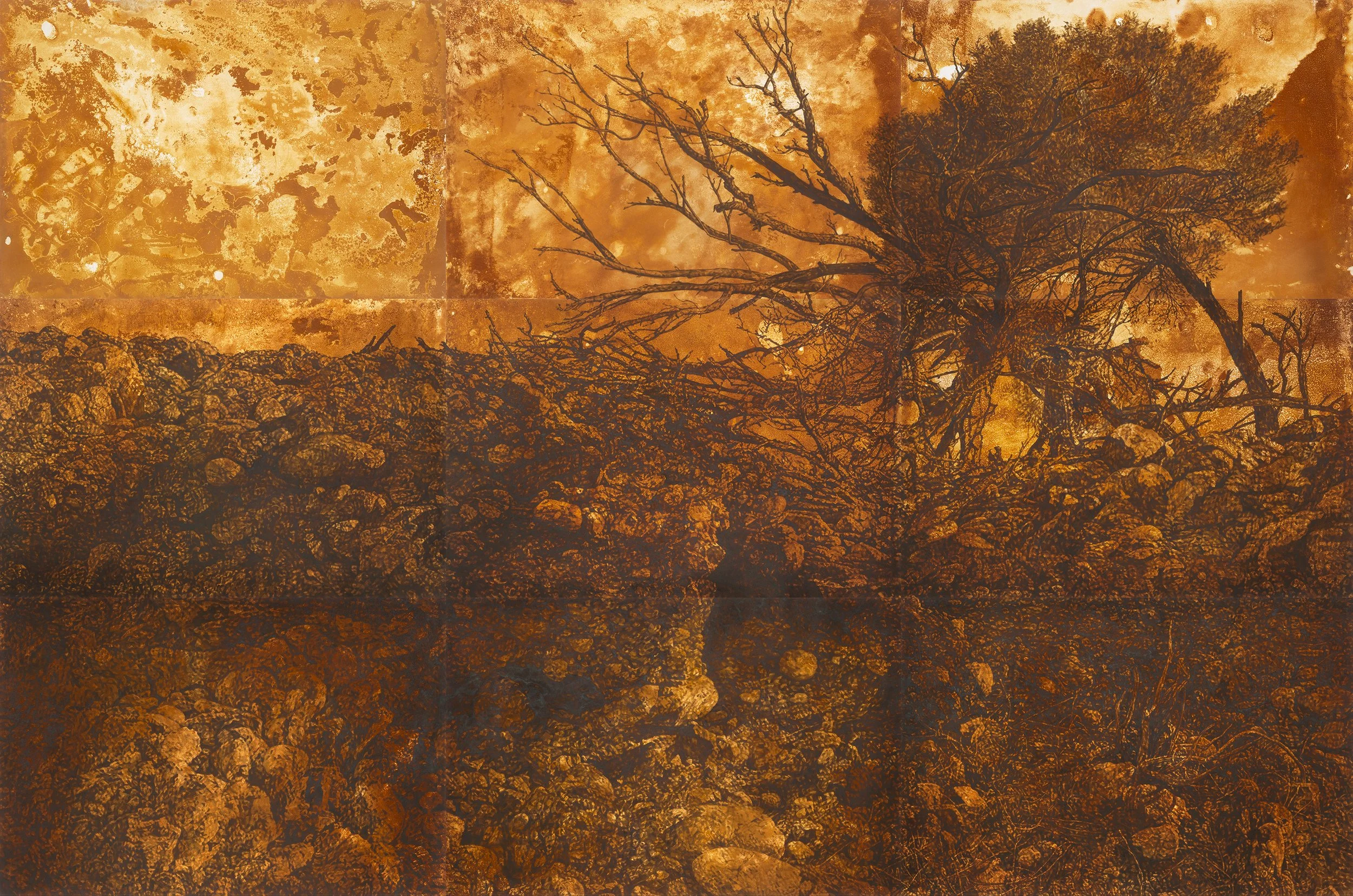Photography by Sammy Hawker.
Annika Romeyn
Based in Kamberri/Canberra on Ngunnawal Country, Annika Romeyn combines printmaking, drawing and watercolour to create intricate and immersive works on paper. Seeking to convey the humbling and restorative experience of walking in nature, Romeyn investigates personal understandings of place alongside broader environmental concerns.
Romeyn recently received the Canberra Arts Patrons’ Organisation 2023 Mandy Martin Art and Environment Award and is past winner of the 2024 River of Art Prize, 2021 Burnie Print Prize, 2020 Fisher’s Ghost Art Award, 2020 National Works on Paper Award, 2019 Commendation Prize for the Banyule Works on Paper Award and was Highly Commended in the 2019 Megalo International Print Prize.
Romeyn is represented by Flinders Lane Gallery, Naarm/Melbourne.
Annika Romeyn, Old Mutawintji Gorge 1, 2023, watercolour monotype on paper, 168 x 228cm. Photography by Brenton McGeachie.
Tell us about your creative process. What drives your practice?
In my own way, I’d like to contribute to a shift towards a more caring way of seeing, valuing and relating to the natural environment. I’m also spurred on by the process of bringing each ambitious new work into being and sharing it with others.
Over the years I’ve been consistently drawn to the threshold of rock and water where humbling reminders of geological time intersect with daily, seasonal and climatic changes.
My process starts with walking as a way to build a relationship with a particular place. In some cases, these walks have been shared with loved ones, embedding personal memories and significance in how I think of a place. In other cases, opportunities to walk with First Nations Custodians have been pivotal in the ongoing process of learning about and Acknowledging Country.
I will often revisit sites from multiple perspectives, or over multiple days or years, initially making small sketches as a way to slow down and be present. Then, from the distance of my studio, I’ll work free-hand from my own photographic reference, recalling and reanimating my experiences in nature.
How does the gestural and ephemeral nature of monotype processes contribute to your engagement with site/place and time?
Working with monotype allows me to freely combine aspects of drawing, printmaking and watercolour painting. My process involves applying watercolour to a sheet of polypropylene before transferring it to damp paper with the strong pressure of an etching press. I work back and forth, building up paint with a brush and subtracting paint using a damp cloth wrapped around my fingertip.
Incorporating the direct, intimate touch of my fingertip is a physical gesture of care, value and connection, expressed through the patient accumulation of thousands of small marks over an extended period of time. Where my reference photographs seem to flatten down the depth of the experiences that I want to convey, monotype is my way of breathing life back into the image by entering into a fleeting moment and opening it out.
I often let the fluidity of watercolour direct the atmosphere of my work, contrasting precise and intricate detail with washes and drips poured across the non-absorbent plastic monotype ‘plate’. These more unpredictable marks signify a release of control, visually linking realms of sea and sky, and suggesting the intersection of internal and external landscapes.
Annika Romeyn, Endurance 10, 11 & 9 at Ellen José Art Award, Bayside Gallery, 2022. Photography by Mark Ashkanasy, image courtesy of Bayside Gallery.
Annika Romeyn, Endurance 14, 2025, watercolour monotype on paper with watercolour additions, 228 x 168cm. Image courtesy of the artist.
Can you expand on the symbolic and evocative use of colour in your works?
Working monochromatically is a way to imbue my work with the quality of a memory. The colours I work with are specific to each site and series. They are ultimately personal choices, both intuitive and considered, related to the emotional, experiential or material dimensions of place.
For example, my Endurance series centres on the environment of Guarella/Guerilla Bay, Yuin Country, South Coast NSW, a place that holds memories of meaningful time spent with my immediate family in the last summer of my mother’s life. In this body of work, ultramarine blue encompasses emotion, memory, distance, beauty and the intangible – as influenced by Rebecca Solnit’s words on ‘the blue of distance.’
“The world is blue at its edges and its depths… The colour of that distance is the colour of an emotion, the colour of solitude and desire, the colour of there seen from here, the colour of where you are not. And the colour of where you can never go. For the blue is not in the place those miles away at the horizon, but in the atmospheric distance between you and the mountains.”– Rebecca Solnit, A Field Guide to Getting Lost
Your works often play with scale, corresponding to your outstretched body. How does this relationship with the body underscore your making and its experiential intent?
As an emerging artist, I spent about 5 years working with lithography and while I loved the feeling of drawing on weighty slabs of limestone, I began to feel that the prints did not quite do justice to the places I was responding to.
I also wanted to resist the conventions of Australian colonial landscape paintings, which seemed too conveniently contained within medium scale frames. While Romantic painters often included small figures in their work to imply scale, I wanted my work to have a direct relationship to my body, and to the body of the viewer. Rather than a picture to be held and possessed, I wanted to physically draw the viewer into the work and create a more immersive experience in the gallery space.
I’m also interested in the interplay between scale and mark-making, which encourages viewers to alternately approach and step back from the work – the image coming into sharper focus from a distance and breaking down into more abstract flecks of light and dark finger and brush marks on closer inspection.
Annika Romeyn, Wana Karnu, 2024, acrylic ink and rust on paper, 240 x 360cm. image courtesy of the artist.
Are there any female printmakers | artists that infuence you?
There are lots of inspiring women printmakers that influence me in different ways. Leah Bullen inspired me to dive into my first experiments with watercolour monotype and generously shared some tips on the process. It was exciting to see how adaptable this technique was to our individual painting and mark-making sensibilities.
Being completely encircled by Bea Maddock’s epic work Terra Spiritus … with a darker shade of pale 1993 – 98 at NGV was another particularly influential moment that enabled me to see the immersive potential of print as installation. Maddock’s use of European and First Nations place names in tracing the entire coast of lutruwita/Tasmania was also a powerful and ground-breaking way of thinking about place.
Antonia Aitken’s approach to the practice of walking, Rebecca Mayo’s centering of care, Alison Alder’s feminist print projects and G. W. Bot’s distinctive responses to the Australian landscape have also been inspiring. However, these women have also been important supporters and role models for me as part of the art community in Canberra.
Finally, what exciting projects are you working on at the moment?
I’m excited to be included in two curated exhibitions at the moment: Seasonal Shifts at Town Hall Gallery, Naarm/Melbourne, on display until 26 April and The Shape of Things to Come at Shepparton Art Museum, Yorta Yorta Country, on display until 9th June.
In March I’m looking forward to returning to Far West NSW, and continuing to experiment with rust, following on from my 2024 work Wana Karnu which incorporated burnt orange tones transferred directly from rusting steel to paper. Supported by the Canberra Arts Patrons’ Organisation’s Mandy Martin Art and Environment Award, this project is about inviting a natural process to inform and disrupt my drawing, while referencing the interaction of iron, oxygen and water in the environment of Mutawintji National Park, Barkindji and Malyangapa Country.





